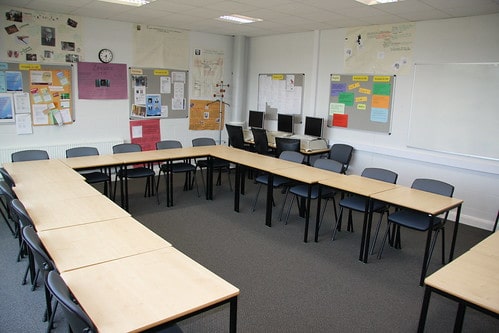Students, teachers, and the curriculum all have different demands, therefore school design is always changing. For that purpose, anyone planning to renovate existing classrooms or build new ones should make sure their designs match contemporary educational trends. Interior architecture designs in modern schools must represent the concepts of creativity and critical thinking. There are numerous factors to consider when designing a 21st-century classroom, but we believe the following six are the most important.
6 Important Design Factors for a 21st-Century Classroom
1. Collaborative environments.
Schools are shifting away from the “I teach, you listen” model of instruction and toward a more Socratic approach. As a result, locations that allow for a variety of activities, such as working out difficulties in big groups, debating literature in small groups, or silently focusing on projects alone, are required. While students must direct their work while they’re on their own, it’s equally critical for professors to monitor and supervise these areas.
2. Modular furniture.
Innovative classroom furnishings that enable active learning and teamwork are a must in collaborative settings. Modern caster-based workstations are readily set to support both group and individual work and can be moved aside to entirely open up the room. Whiteboard or stain-resistant surfaces on desks and tables
3. Use of natural light.
The days of narrow windows and low ceilings in classrooms are over. Moreover, children learn better in areas with plenty of natural light, according to research. Large windows and wide, roll-up outside doors blur the boundary between inside and out.
4. Use vibrant colors.
In today’s classrooms and learning spaces, architectural design teams are using a lot more color. Pre-K–8 interiors are more whimsical in both color and design features, whereas high schools have a more refined color palette. Color doesn’t have to be limited to bold wall paint options. An interiors team will work with an expert architect to choose acceptable colors for carpets, wall treatments, and furnishings.
5. Use of technology.
Technology is an essential component of any classroom in the twenty-first century. Because students study and create using computers and mobile devices, classroom design must accommodate technological improvements that encourage exploration and experimentation. Moreover, you may encourage collaboration and creative learning by building a wall that doubles as a whiteboard and a projection surface. Outlet placements and tables with built-in electrical outlets and mobile device chargers should also be considered for optimum tech and curriculum flexibility. A skilled architect will assist you in meeting your present technological requirements while also providing designs that anticipate future developments.
Hands-on learning is number six. Schools are embracing a more hands-on form of learning, in addition to a focus on cooperation. Students who like science and technology can use “maker spaces” to develop their creative muscles while experimenting, inventing, and building.
Conclusion
Your school is one of a kind. Explore engaging with an expert architectural firm as you consider the 21st-century classroom design characteristics that will support your specific curriculum. Partner with a design team that has the expertise to assist you in creating a modern learning environment that will increase student learning today while also adapting to your future demands.
Read more on INJ Architects:
The Three Most Important Non-Architecture Skills You Learn in Architecture School
The Role of the Architect in Maintaining a Healthy Lifestyle Through the Right Architectural Design

